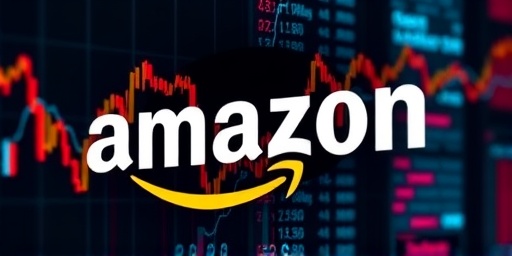In a resounding vote of confidence for the tech sector, the S&P 500 climbed 1.8% to close at a fresh record of 5,678 points on Friday, while the Nasdaq Composite surged 2.5% to 18,492, propelled by robust investor enthusiasm for artificial intelligence initiatives. Amazon’s shares rocketed to an unprecedented peak, gaining 4.2% and capping off a stellar week that underscores the stock market’s growing reliance on AI-driven growth.
- Amazon’s AI Ambitions Propel Shares to Record Heights
- Big Tech’s AI Spending Spree Ignites Broader Market Optimism
- S&P 500 Reaches New Peaks Amid AI-Fueled Economic Tailwinds
- Investor Sentiment Shifts as AI Hype Meets Real-World Applications
- Outlook: AI Momentum Sets Stage for Prolonged Stock Market Gains
Amazon’s AI Ambitions Propel Shares to Record Heights
At the forefront of the rally was Amazon, whose stock price touched $195 per share for the first time, marking a 28% increase year-to-date. The e-commerce and cloud computing giant’s performance was supercharged by announcements of escalated investments in AI infrastructure through its AWS division. During a recent earnings call, Amazon CEO Andy Jassy highlighted that the company plans to allocate over $75 billion to AI and machine learning projects in the coming year, a figure that dwarfs previous commitments and signals a strategic pivot toward generative AI tools.
Analysts attribute this surge to Amazon’s integration of AI across its vast ecosystem, from personalized shopping recommendations to automated logistics. ‘Amazon is not just dipping its toes into AI; it’s diving headfirst, and the market is rewarding that boldness,’ said Sarah Thompson, a senior tech analyst at Morningstar. Shares of Amazon outperformed the broader Nasdaq index, adding over $100 billion to the company’s market capitalization in a single day. This momentum comes amid reports that AWS alone generated $25 billion in quarterly revenue, with AI services contributing a staggering 35% growth rate.
The ripple effects were felt across Amazon’s supply chain partners and competitors alike. For instance, semiconductor suppliers like Nvidia, which powers much of Amazon’s AI computations, saw their own shares jump 3.1%, further amplifying the Nasdaq’s gains. Investors are betting that Amazon’s AI push will not only streamline operations but also unlock new revenue streams, such as AI-enhanced advertising platforms projected to add $10 billion annually by 2025.
Big Tech’s AI Spending Spree Ignites Broader Market Optimism
The stock market’s upward trajectory is inextricably linked to a wave of corporate spending on AI, with major players committing billions to stay competitive in this transformative field. Beyond Amazon, Microsoft announced a $10 billion expansion of its Azure AI capabilities, while Google revealed plans for $12 billion in AI research and development. These investments are fueling a narrative of sustained innovation that has investors overlooking short-term inflationary pressures.
According to a report from McKinsey Global Institute, global AI spending is expected to reach $200 billion by 2025, up from $50 billion in 2023, with the U.S. stock market poised to capture the lion’s share. This optimism is palpable in the S&P 500, where technology stocks now comprise 32% of the index, the highest weighting in over two decades. ‘The AI revolution is reshaping the economic landscape, and companies that lead in this space are seeing their valuations soar,’ noted economist Dr. Elena Vasquez during a CNBC interview.
Key statistics underscore the frenzy: Venture capital funding for AI startups hit $48 billion in the first half of the year, a 40% increase from the previous period. This influx is trickling down to public markets, where AI-themed ETFs have outperformed the S&P 500 by 15% year-to-date. However, not all sectors are sharing in the bounty; traditional industries like energy and utilities lagged, with the S&P 500 energy sector dipping 0.5% amid concerns over AI’s energy-intensive demands.
- Microsoft’s AI investments: Enhanced Copilot tools driving 20% productivity gains for enterprise users.
- Google’s AI focus: Bard chatbot upgrades expected to boost ad revenues by 12%.
- Overall impact: Nasdaq’s tech-heavy composition benefits most, with 70% of its constituents tied to AI advancements.
Wall Street’s bulls argue that this AI spending is not speculative but foundational, akin to the internet boom of the 1990s. Yet, whispers of overvaluation persist, with the Nasdaq’s price-to-earnings ratio hovering at 35, well above the historical average of 25.
S&P 500 Reaches New Peaks Amid AI-Fueled Economic Tailwinds
The S&P 500’s ascent to 5,678 points represents its seventh record close in the past month, a testament to the index’s resilience in the face of geopolitical uncertainties. Comprising 500 leading U.S. companies, the benchmark has gained 22% since the start of the year, outpacing global peers like the FTSE 100 and Nikkei 225. Central to this performance is the AI sector’s dominance, which has offset weaknesses in consumer discretionary stocks battered by lingering inflation.
Federal Reserve data indicates that AI-related capital expenditures have surged 25% quarter-over-quarter, contributing to a 3.2% GDP growth forecast for the year. In the stock market arena, this translates to heightened trading volumes, with the S&P 500 seeing average daily trades of 4.5 billion shares last week. ‘The S&P 500 isn’t just rising; it’s being redefined by AI innovators,’ remarked portfolio manager James Lee of BlackRock in a recent Bloomberg op-ed.
Diving deeper, the index’s top performers included AI beneficiaries like Tesla, whose shares rose 2.8% on news of AI-optimized autonomous driving software, and Apple, up 1.9% after unveiling AI features in its latest iOS update. Conversely, the S&P 500’s diversified nature provided a buffer; financials climbed 1.2% on expectations of rate cuts supporting lending activity. Historical context reveals that the current bull run echoes the post-2008 recovery, but with AI as the accelerator rather than monetary policy alone.
- Record closes: S&P 500 surpasses 5,600 for the first time since March.
- Sector breakdown: Tech leads with +3.1%, followed by communications at +2.4%.
- Volatility index: VIX drops to 14.5, signaling reduced investor fear.
Market watchers point to upcoming earnings seasons as a litmus test, with 80% of S&P 500 companies expected to beat AI-influenced revenue projections.
Investor Sentiment Shifts as AI Hype Meets Real-World Applications
As the Nasdaq notched its highest level since November 2021, investor sentiment surveys reveal a marked shift toward AI optimism. The AAII Investor Sentiment Index jumped to 65% bullish readings, the highest in six months, driven by tangible AI applications emerging in everyday business. For instance, Amazon’s use of AI in warehouse automation has reduced fulfillment times by 30%, a metric that resonated with retail investors during recent webinars.
Quotes from market luminaries add color to the narrative. ‘AI isn’t a bubble; it’s the next industrial revolution, and the stock market is pricing it in accordingly,’ stated Cathie Wood, CEO of ARK Invest, whose AI-focused funds have returned 45% year-to-date. On the Nasdaq front, the index’s 2.5% gain was broad-based, with biotech firms leveraging AI for drug discovery seeing outsized moves—Moderna’s stock leaped 3.7% on AI-accelerated vaccine trials.
Contextually, this surge occurs against a backdrop of moderating inflation, with the CPI at 3.1%, allowing the Fed room to pivot toward growth-supportive policies. The stock market’s AI enthusiasm has also drawn retail participation, with Robinhood reporting a 50% uptick in AI stock trades. However, regulatory scrutiny looms; the SEC’s probe into AI disclosure practices could temper the euphoria if transparency issues arise.
Broader implications include job market shifts, where AI is projected to create 97 million new roles by 2025 per the World Economic Forum, bolstering consumer spending and S&P 500 stability.
Outlook: AI Momentum Sets Stage for Prolonged Stock Market Gains
Looking ahead, the interplay of AI investments and stock market dynamics suggests a protracted period of gains for the S&P 500 and Nasdaq. Analysts from Goldman Sachs forecast the S&P 500 reaching 6,000 by year-end, contingent on uninterrupted AI progress and no major economic shocks. Amazon’s trajectory, in particular, could see further upside if its AI ventures yield double-digit revenue growth in Q4 earnings.
Forward-looking strategies for investors include diversifying into AI ETFs like the Global X Robotics & Artificial Intelligence ETF, which has mirrored the Nasdaq’s rise. ‘The key is sustainability—companies must convert AI spending into profits to maintain this momentum,’ advised Thomson Reuters market strategist Nick Timiraos. Potential headwinds, such as supply chain bottlenecks for AI chips, could introduce volatility, but the consensus leans bullish.
In the evolving landscape, the stock market’s embrace of AI positions the U.S. as a global leader, with implications for international trade and innovation policy. As corporate boards continue to prioritize AI, expect the S&P 500 and Nasdaq to ride this wave well into 2024, rewarding patient investors attuned to technological shifts.









